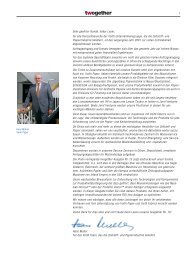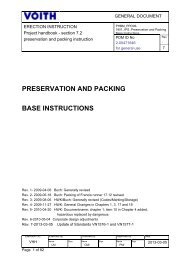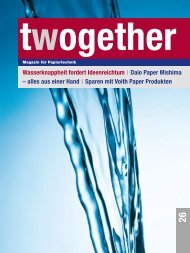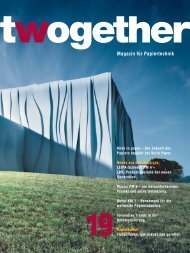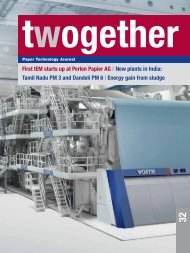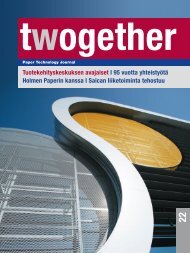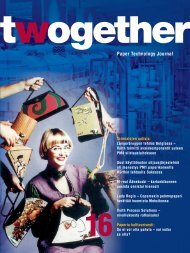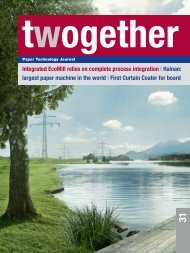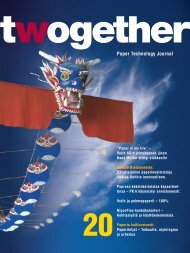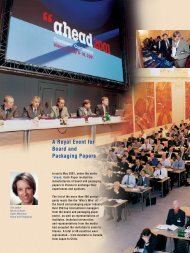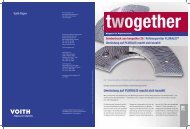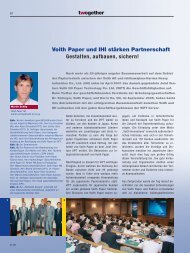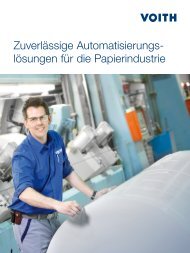Paper Technology Journal 19 - Voith
Paper Technology Journal 19 - Voith
Paper Technology Journal 19 - Voith
Create successful ePaper yourself
Turn your PDF publications into a flip-book with our unique Google optimized e-Paper software.
taken into account later during finishing<br />
or optimized cutting.<br />
An integrated representation of quality<br />
deviations and paper defects in connection<br />
with cutting optimization is, therefore,<br />
desirable. A so-called color map can<br />
show color-coded quality data and paper<br />
defects together (Fig. 4).<br />
<strong>Paper</strong>Miner<br />
In the above example of a color map, a<br />
relatively small amount of specific information<br />
is sufficient to allow a meaningful<br />
analysis. In paper production, however, –<br />
this is rather the exception. As a rule, the<br />
interrelations are complex and difficult to<br />
identify, although or because a huge<br />
amount of data is available. For example,<br />
the question under which process conditions<br />
good printability is achieved cannot<br />
be answered by simple means.<br />
These and similar questions are typical<br />
tasks for the <strong>Paper</strong>Miner. But first, the<br />
data must be collected and prepared for<br />
the <strong>Paper</strong>Miner. The <strong>Paper</strong>Miner can pick<br />
up its information from this data pool.<br />
The <strong>Paper</strong>Miner provides a number of<br />
methods for analysis. The most important<br />
ones of these are the so-called Self-<br />
Organizing Maps and Decision Trees,<br />
which originate from the area of “machine<br />
learning methods”.<br />
These techniques allow both modelbased<br />
forecasts and a deeper insight into<br />
the process interrelationships.<br />
In the case of “Self-Organizing Maps<br />
(SOMs)”, the system starts with a continuous<br />
data set, which may comprise hundreds<br />
of data for one parent roll and reproduces<br />
the data on a two-dimensional<br />
display. Each data set is assigned to one<br />
spot on the display.<br />
The SOM method can be used for forecasts<br />
with good success. Once a SOM<br />
has been generated, the place of a modified<br />
machine setting can be determined<br />
on the two-dimensional map, and it can<br />
be used to determine the expected values<br />
for the desired target parameters (porosity,<br />
formation etc.). Of course, the quality<br />
of such forecasts is greatly dependent on<br />
the number of data sets used to generate<br />
the map, and whether or not all major influences<br />
were included.<br />
Decision Trees are another method of<br />
analysis. In order to use Decision Trees,<br />
a target value to be analyzed is first selected.<br />
The decision tree can then be<br />
used to find out which process adjustments<br />
must be made.<br />
Generally, it can be said that the <strong>Paper</strong>-<br />
Miner is a very efficient tool for data<br />
analysis. It is capable of handling large<br />
volumes of numerical and non-numerical<br />
data (such as grades, felt type, ...). It<br />
provides a high quality of results even for<br />
59<br />
complex physical relationships and facilitates<br />
the understanding of the process.<br />
This allows forecasts of process behavior,<br />
for example. However, the methods<br />
require good data quality from a large<br />
amount of data available, and they cannot<br />
be mastered without basic technological<br />
knowledge.<br />
System-integrated Process<br />
Analysis<br />
Due to networking via Ethernet and the<br />
communication standard OPC, it is today<br />
possible to exchange and link data, regardless<br />
of the place of their acquisition<br />
within a system’s network. This now provides<br />
a uniform user interface that allows<br />
functional data integration between QCS,<br />
DCS and other systems.<br />
This is particularly important for all systems<br />
that provide process information.<br />
These include:<br />
● Reporting of the quality control system,<br />
● Web inspection,<br />
● Web break analysis,<br />
● The bearing monitoring system,<br />
● The technology monitoring system,<br />
● The traditional distributed control<br />
system and more.<br />
All data acquired by means of these systems<br />
will be available in a central database<br />
in the future and can be linked to<br />
each other. This makes physical relationships<br />
visible and allows them to be<br />
processed in a total plant visualization for<br />
the operator.<br />
<strong>19</strong>/05<br />
5



